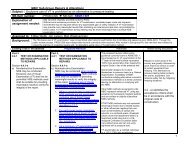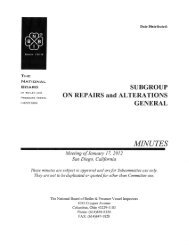bulletin - The National Board of Boiler and Pressure Vessel Inspectors
bulletin - The National Board of Boiler and Pressure Vessel Inspectors
bulletin - The National Board of Boiler and Pressure Vessel Inspectors
You also want an ePaper? Increase the reach of your titles
YUMPU automatically turns print PDFs into web optimized ePapers that Google loves.
COVER 74TH GENERAl STORY<br />
MEETING HIGHlIGHTS<br />
14<br />
In general, firetube boilers produce<br />
more steam than watertube boilers<br />
because more water is heated. On<br />
the other h<strong>and</strong>, watertube boilers are<br />
faster at getting steam to working<br />
pressures because the small quantity<br />
<strong>of</strong> water in the tubes can be heated<br />
more quickly than the large quantity<br />
<strong>of</strong> water in the firetube boiler.<br />
By the late nineteenth century,<br />
steamer boilers were all built from<br />
riveted sheets <strong>of</strong> steel ½- to ¾-inches<br />
thick. Some were decorated with brass<br />
or nickel-plated brass or even silver.<br />
Most were less than eight-feet high,<br />
<strong>and</strong> none were built wider than four feet. <strong>The</strong>y usually held 30 to 40<br />
gallons <strong>of</strong> water.<br />
When at rest in the firehouse, the steamer boiler was usually connected<br />
by two quick-release couplings to a stationary boiler, which fed the<br />
former low-pressure steam. At an alarm, the stationary boiler was<br />
disconnected, <strong>and</strong> the firebox lit. Within three to five minutes, the<br />
engine could generate 40 to 50 pounds <strong>of</strong> steam; within 10 minutes,<br />
70 to 80. At the fire, the pump, depending on the amount <strong>of</strong> hose laid<br />
out <strong>and</strong> the number <strong>of</strong> lines in use, generated between 70 <strong>and</strong> 120 psi.<br />
Though steam fire engines <strong>of</strong>ten malfunctioned, their boilers rarely<br />
exploded. Dr. Peter Molloy, who is director <strong>of</strong> the Hall <strong>of</strong> Flame<br />
Museum <strong>of</strong> Firefighting in Phoenix, Arizona, <strong>and</strong> who spoke at the<br />
75th General Meeting <strong>of</strong> the <strong>National</strong> <strong>Board</strong> (see page 17), has<br />
documented only two incidents. <strong>The</strong> first involved the very engine<br />
that revolutionized firefighting — the Uncle Joe Ross. On December 6,<br />
1855, as Alex<strong>and</strong>er Latta demonstrated it to some Chicago firemen,<br />
a hose burst, <strong>and</strong> the engine was shut down. Steam pressure rose to<br />
180 psi, <strong>and</strong> the boiler exploded; the engineer <strong>and</strong> two byst<strong>and</strong>ers<br />
were killed. <strong>The</strong> second was in 1868, when the boiler on an Amoskeag<br />
exploded because the engineer had tied down the leaky safety valve.<br />
<strong>The</strong> engineer survived, but five other people were killed <strong>and</strong> 23 injured.<br />
Swift agrees explosions were rare. “I have a lot <strong>of</strong> photographs <strong>of</strong><br />
steamers working, but I don’t think I’ve ever seen a picture <strong>of</strong> a<br />
steamer that’s come unwrapped. You would think that, if they did<br />
NATIONAl BOARD BUllETIN/FAll 2006<br />
Watertube boiler <strong>of</strong> an<br />
1892 Ahrens.<br />
blow up, the press would have gotten<br />
pictures.”<br />
To say Swift is conscious about safety<br />
is an understatement. When customers<br />
tell him they want their steamers<br />
restored because they want to “throw a<br />
stream <strong>of</strong> water” whenever they get a<br />
chance, he thoroughly interviews them<br />
to make sure they know how to safely<br />
operate the steamers. “When you’re<br />
dealing with live steam, I can do everything<br />
right. But if the operator does the<br />
wrong thing, he can turn that boiler<br />
into a grenade very easily. If you’re a<br />
cowboy, I don’t want to talk to you.”<br />
Customers are not the only ones he talks to. “I’ve also got to talk to<br />
the boiler inspectors <strong>of</strong> the states that these steamers are going to.”<br />
If he is satisfied the customer will operate the steamer safely, he<br />
then examines the boiler, which can be as layered as an onion. One<br />
<strong>of</strong> the boilers he is working on now is jacketed with three sheets<br />
<strong>of</strong> glass <strong>and</strong> gold. Underneath that is a lagging <strong>of</strong> wood. Underneath<br />
that, to protect the wood, is a woven sheet <strong>of</strong> asbestos. “<strong>The</strong><br />
jacketing <strong>and</strong> wood <strong>and</strong> asbestos insulate that boiler to keep it more<br />
efficient, to keep it hotter longer,” he says. “And until I take <strong>of</strong>f all<br />
that jacketing, all that lagging, <strong>and</strong> all that asbestos, I don’t know<br />
anything about that boiler.”<br />
When he finally pulls <strong>of</strong>f all the layers, he brings in someone to<br />
do an ultrasound <strong>of</strong> the boiler’s thickness. One area susceptible to<br />
corrosion — an area Swift calls “a real nasty place” — is the area <strong>of</strong><br />
the water level. “Where the water is boiling, where air is coming out<br />
— that’s where it will corrode the worst. That’s where a guy who<br />
knows his stuff will put his ultrasound. Another area to watch is<br />
around corners, around a sheet making a 90-degree bend — that’s<br />
where you want to watch because the stress <strong>of</strong> making that bend is<br />
also susceptible to corrosion. And <strong>of</strong> course there’s the crown sheet<br />
<strong>and</strong> all the corners around the crown sheet.”<br />
If the boiler is in good condition, Swift tests it hydrostatically at<br />
what he thinks is a safe working pressure. If the boiler is in poor








